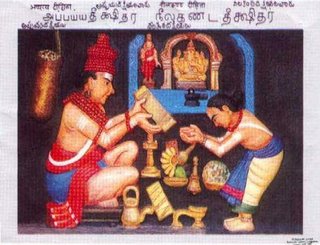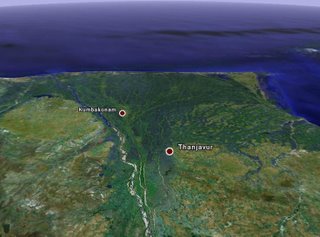Amar Singh, the Maharaja of Kanota, near Jaipur,
has been the subject of a study by the Rudolphs: Reversing the
Gaze: Amar Singh's Diary, A Colonial Subject's Narrative of
Imperial India. Edited and Commentary by Susanne Hoeber
Rudolph and Lloyd I. Rudolph with Mohan Singh Kanota.
Boulder: Westview, 2002 (good review by Michael Fisher).
Amar Singh's diaries, covering 1898-1905, are about 89 vols,
each with 800 pages. I think Amar Singh was probably a little
eccentric. His diaries are very, very detailed, and not always
interesting. Except, of course, that in the mass of detail, there
are inevitably nuggets. He was a prominent and even eminent
military man, so one finds details of his meetings with
important players of the time, though what he writes about
them often extends only to what colour gloves they wore, or
which side of the carriage they got out.
Anyhow, I discovered this diary many years ago, through
accidentally meeting Mohan Singh Kanota (I stayed at the
Narain Niwas hotel in Jaipur, must have been in the 1980s),
and being taken out to Kanota to see the old man's library.
Although the Rudolphs have focussed on the diaries, it is
less well known that Amar Singh was also a passionate cook.
Or, perhaps, "supervisor of cooking" (as he was a supervisor
of photography also). His favourite hobby was to sit on the
veranda in the evening and direct a team of cooks in making
up dishes using recipes from classical sources. He drew on
many culinary traditions, including those recorded in Persian
and Sanskrit. Predictably, he wrote everything down. So along
one wall in the family home in Kanota there are many metres
of Amar Singh's cooking diaries. It is multilingual, with
text in Persian, Hindi, and Sanskrit. Possibly English, I
can't remember.
I am not aware that anyone has written about Amar Singh's
cookery diaries. His ordinary diaries have been microfilmed
and are on deposit at the University of Chicago library. I
don't know whether the cookery diaries were also filmed;
probably not.
This leads me on to mention the classical tradition of Indian
cookery, Skt. pākaśāstra पाकशास्त्र("Cooking Science"). There's
not much written about this, with one exception. Meulenbeld
notes 34 of the texts on this subject in his History of
Indian Medical Literature, IIa, part 9.1 (pp.415-20), and
gives detailed accounts of the contents of several of them.
As Meulenbeld points out, "pāka पाक" means a "linctus", as well
as "cookery", so not all the works on pāka śāstra are
actually on "medical cookery"; some are on linctus formulae.
Works on cookery in the Pāka Śāstra tradition seem to date
from AD 1200 and perhaps earlier. One of the earliest is the
Pākadarpaṇa पाकदर्पण or Nalapāka नलपाक ascribed to King Nala. It's a
work in 760 verses divided into 11 chapters, intended to inform
the cooking in a royal kitchen.
Friday, September 29, 2006
Tuesday, August 22, 2006
intratext.com
I've just discovered www.intratext.com. An interesting service. Already has some trs. of Sanskrit and Pali texts. Has the Skt text of the RV in ITRANS format. Thought-provoking. Should we all jump on board?
Tuesday, June 27, 2006
Isidore of Charax
I've been doing a bit of work on Isidore of Charax's Parthian Stations. Thinking out loud, really, about the actual route, and what kind of communications might have been possible between the Mediterranean/ME and Afghanistan/India in the centuries around the beginning of the Common Era.
See http://tinyurl.com/fffzz/
See http://tinyurl.com/fffzz/
Thursday, May 25, 2006
Appaya Dikshita and Nilakantha Dikshita
 Appaya Dikshita (b. ca.1520,
Appaya Dikshita (b. ca.1520,d. 1592) transfers his copy of the Devimahatmya to his grand nephew Nilakantha Dikshita (1580--ca. 1644), just before he passes away. This happened at Cidambaram.
The account of Appaya's deathbed transfer of his
cultural and spiritual heritage to the twelve-year-old Nilakantha is
given in the biographies of Nilakantha, the
Srinilakanthadhvaricaritam of Appaya, the
Sriappayadiksitendravijaya, both composed by Appaya's
nineteenth-century descendant Sivananda Yogindra. The former text
is translated and reprinted by Pierre-Sylvain Filliozat,
Oeuvres Po'etiques de Nilakantha Diksita I (1967), pp.7, 349. P-S Filliozat also
gives information from the latter text and other sources,
(ibid., 4).
My thanks to Yigal Bronner for drawing my attention to this image.
We're working to find out its source.

Govinda Dikshita and his wife Nagamba
Sunday, April 16, 2006
V. M. C. Sankaran Nambudiri
 At the age of about 85 (in October 2005), V. M. C. Sankaran Nambudiri is one of the most respected teachers of ayurveda in Kerala today, and a great expert in Viṣavidyā. Pictured here at his home near Trissur, with his daughter and grandson Brahmadattan (on the bed behind him), and his pupils (Dr Madhu in the white shirt). See also the documentation at PADAM .
At the age of about 85 (in October 2005), V. M. C. Sankaran Nambudiri is one of the most respected teachers of ayurveda in Kerala today, and a great expert in Viṣavidyā. Pictured here at his home near Trissur, with his daughter and grandson Brahmadattan (on the bed behind him), and his pupils (Dr Madhu in the white shirt). See also the documentation at PADAM . 
Friday, April 14, 2006
Google Earth kmz file of some S Indian cultural centres

Here's a set of Google Earth data for some cultural centres near Kumbakonam and Thanjavur in southern Tamil Nadu:
Once you have Google Earth running with these place markers, click once on a marker for info (in some cases). Double-click to zoom in for a specific closeup and angle.
Enjoy!
DW
Monday, January 23, 2006
Sarasvatam
Today I discovered Somadeva Vasudeva's blog, http://sarasvatam.blogspot.com/
and that inspired me finally to set up my own blog. However, I'm far from sure that I'll use it.
and that inspired me finally to set up my own blog. However, I'm far from sure that I'll use it.
Subscribe to:
Posts (Atom)



 Nāgāmba, Govinda Dīkṣita's wife.
Nāgāmba, Govinda Dīkṣita's wife. Wrestling
Wrestling The gopuram from the first inner courtyard
The gopuram from the first inner courtyard Govinda Dīkṣita, the great paṇḍit
Govinda Dīkṣita, the great paṇḍit